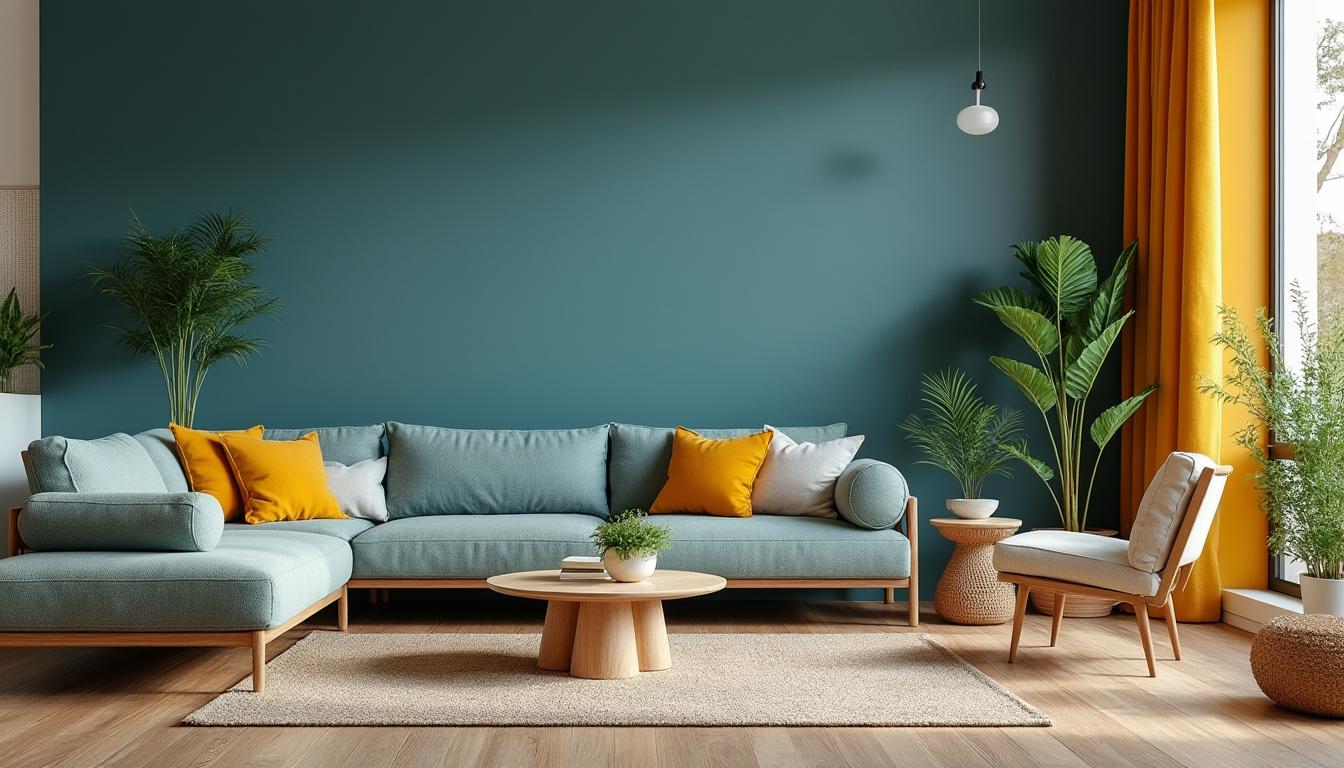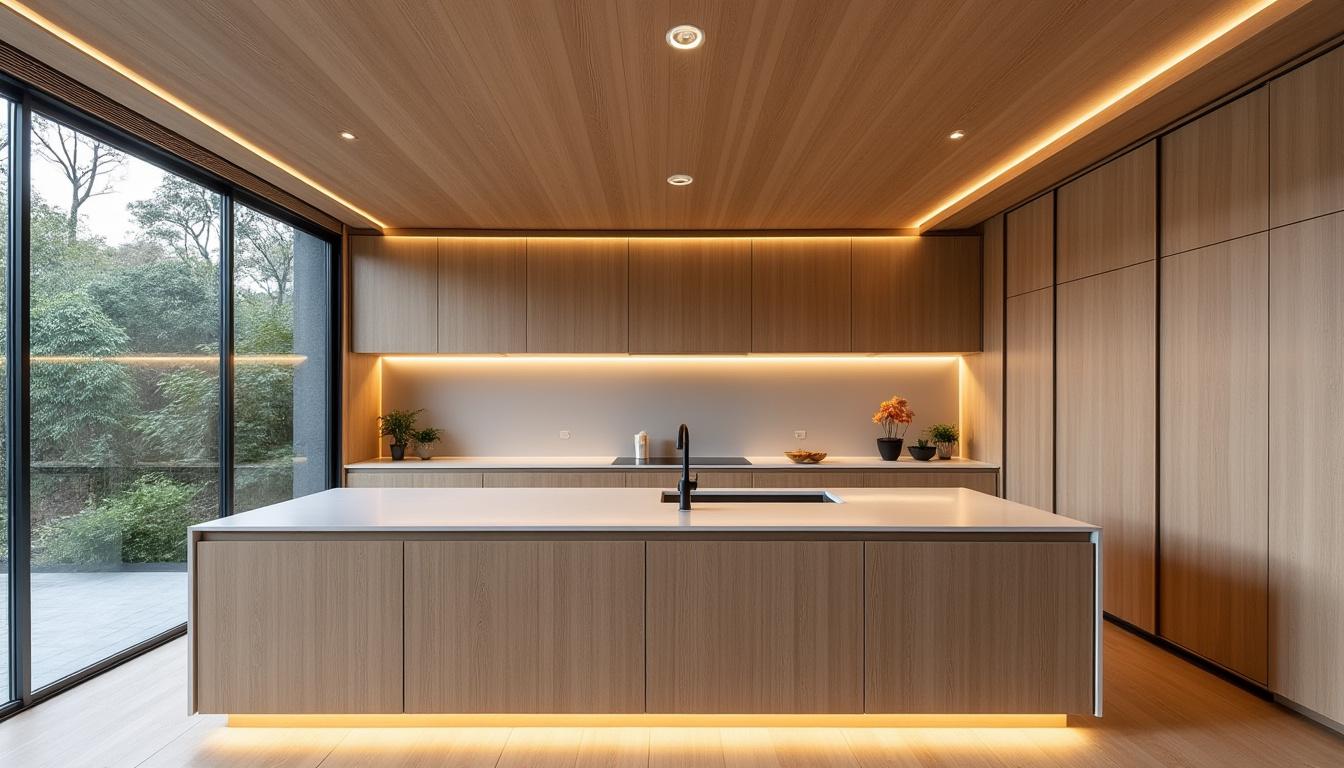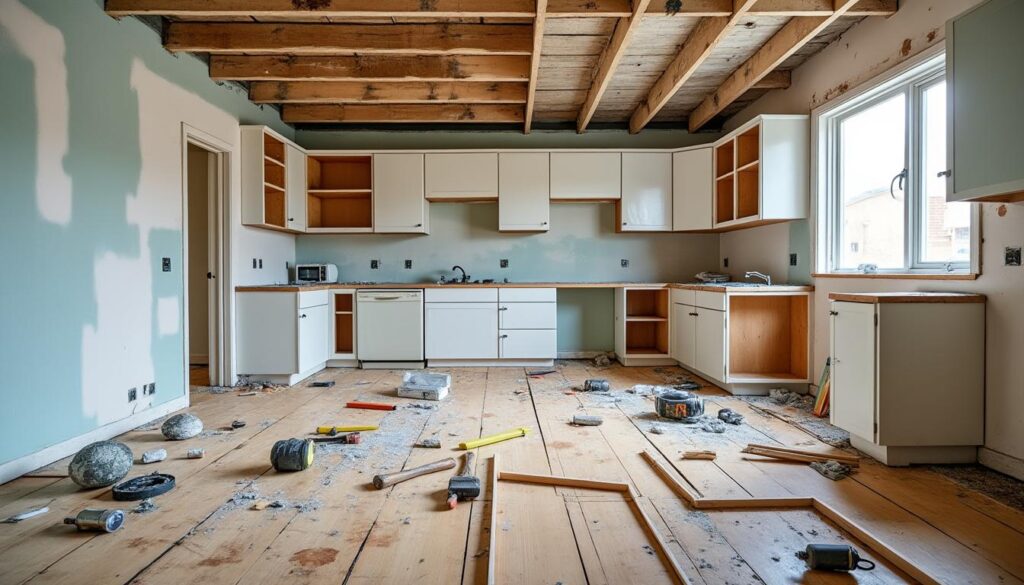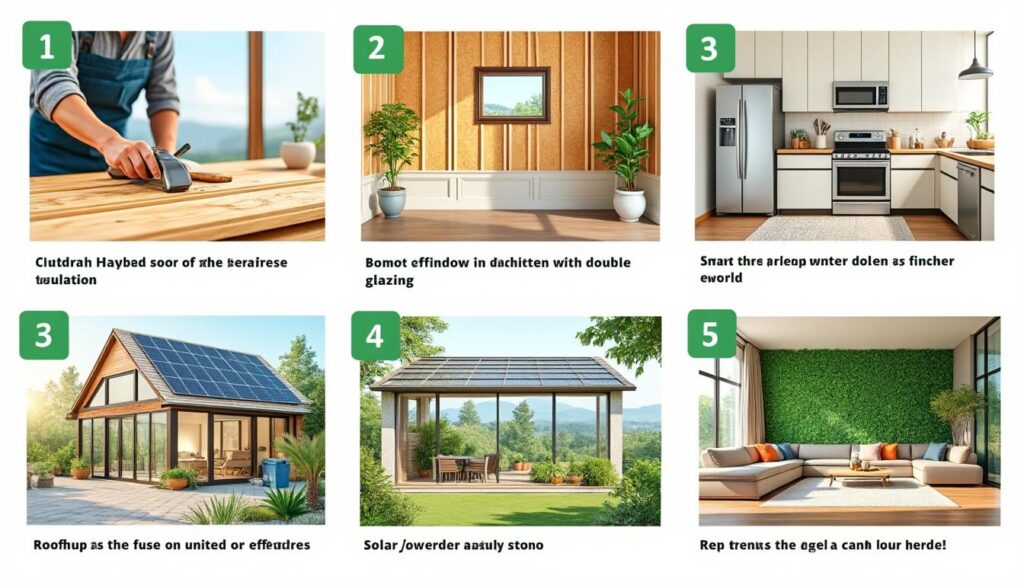Renewing spaces in 2026 is about uniting aesthetics, comfort, and environmental responsibility. This guide shows practical ways to transform your home with smart solutions, sustainable materials, and design choices that truly make a difference.
| Short on time? Here’s the essential: |
|---|
| ✅ Colors 2026: oil blue, mint green, purple, and fuchsia balanced by warm earth tones 🌈 |
| ✅ Materials: prioritize bioproducts, recycled materials, and locally sourced certified woods 🌿 |
| ✅ Technology: “invisible” automation for light, climate, and water, with controlled consumption 🔋 |
| ✅ Layout: open kitchens, multifunctional islands, and modular furniture for micro spaces 🧩 |
| ✅ Style: mix Parisian bourgeois chic with local craftsmanship and enveloping comfort ✨ |
Color palettes 2026 to renew your space without mistakes
The colors of 2026 arrive rich and expressive: oil blue and mint green suggest freshness, while purple and fuchsia bring controlled boldness. Earthy tones like reddish brown and mustard yellow provide warmth and welcoming without being heavy.
This mix favors environments with personality, even if you want to keep the base neutral. The key is to dose: soft walls, striking accents in furniture and accessories, and a continuous palette that links distinct rooms with harmony.
How to compose palettes by environment
In living rooms, opt for deep tones like oil blue on the sofa and mustard in cushions, creating an elegant contrast. In bedrooms, mint green calms and works well with linen textures. Kitchens call for vitality: lower cabinets in earthy tones and upper ones in off-white, with colorful dishes for lightness.
If you’re unsure about saturation, test the 60-30-10 rule: 60% neutral base, 30% soft complements, and 10% vibrant color. This method reduces risks and makes future changes easier.
- 🎨 Quick test: paint a 1 m strip on the wall and observe throughout the day.
- 🕯️ Consider the light: dark colors need good indirect lighting.
- 🧪 Materials: combine color with texture (light wood + purple, raw linen + oil blue).
- 🪞 Mirrors: double the light and soften intense tones.
Common mistakes and how to fix them
Too many vibrant colors in small areas can be tiring. Prefer pointed accents in vases, rugs, and frames. Another mistake is ignoring natural light: a beautiful color in the showroom may darken your living room too much. Measure solar orientation and make samples at home.
For inspiration, events and fairs like Feria Habitat Valencia anticipate palettes that will reach retail in the following semester. Major brands, such as Fermob and Côté Table, confirm the direction towards vibrant tones with a consistent neutral base.
| Environment 🏠 | Base (60%) 🎯 | Complementary (30%) 🎨 | Accent (10%) ✴️ |
|---|---|---|---|
| Living Room | Warm gray or sand | Oil blue | Fuchsia or mustard |
| Bedroom | Off-white or linen | Mint green | Purple (cushions or throw) |
| Kitchen | Satin white | Reddish brown | Mint green (dishes/glassware) |
| Bathroom | Mineral beige | Light graphite | Metallic (copper/brass) |
Practical summary: work in layers and allow seasonal changes in details; this way, your home keeps up with 2026 without radical shifts.

Sustainable and local materials: responsible beauty that lasts
In 2026, the right material matters just as much as the form. Bioproducts from renewable sources, recycled materials, and certified woods take priority, aligning aesthetics with responsibility. This reduces the carbon footprint and supports local economies without sacrificing quality.
Recent studies for 2025-2026 in the furniture and architecture sectors show consumers are more attentive to circular economy and transparency. The result is the appreciation of brands with ethical supply chains and design that extends the product life cycle.
Smart choices for each environment
In the living room, recycled PET rugs bring texture and are easy to clean. In bedrooms, light woods with certification reinforce coziness and credibility. Quartz and porcelain countertops in kitchens improve hygiene, last for years, and have simple maintenance.
Locally produced furniture, such as lines from AM.PM and selections from Maisons du Monde, stand out for combining updated design with environmental commitment. For finishes, portfolios like those of Eucatex present patterns like Freijó Brasil and Cumaru Nativo, which combine beauty with responsible sourcing.
- 🌿 Prefer certified (FSC/PEFC) woods and panels.
- ♻️ Include recycled: PET in rugs, repurposed metals in lamps.
- 🛠️ Repair and reuse: painting, changing handles, and reupholstering extend lifespan.
- 📍 Buy local: less transport, more support for local artisans.
Inspiring real case
In a 68 m² urban T2, a couple replaced a dark floor with certified light wood and used low VOC emission paint. The furniture was partially reupholstered with recycled fabric, and the rug became PET. The result? Brighter environment, easier maintenance, and total cost 18% lower than replacing everything with new.
This type of practical decision gives weight to aesthetics with less environmental impact. By valuing what already exists and prioritizing responsible supply chains, you shorten the path between intention and outcome.
| Material 🌱 | Advantage ♻️ | Application 🧩 | Where to find 🛍️ |
|---|---|---|---|
| Certified wood | Traceability and durability | Floors, panels, furniture | Local carpentries, Eucatex |
| Quartz/porcelain | Low maintenance, high hygiene | Kitchen countertops and floors | Habitat, La Redoute Intérieurs |
| Recycled PET | Reuse of waste | Rugs and throws | Specialized brands and concept stores |
| Natural fibers | Texture and thermal comfort | Curtains, covers, and poufs | Maisons du Monde, AM.PM |
Key guideline: do less, but better. Spot interventions, the right materials, and reliable suppliers ensure longevity with style.
“Invisible” technology: automation that respects design
Automation in 2026 is discreet. Instead of flashy devices, integrated systems prevail that control light, temperature, sound, and water without stealing the focus from the decor. The goal is immediate comfort, energy efficiency, and a clean look.
Solutions from high-end furniture brands, like Ligne Roset and Roche Bobois, already incorporate built-in chargers, adjustable lighting, and hidden cables. In parallel, affordable platforms popularize sensors and programmable scenes for real routines.
How to plan without complicating
Map uses: arriving home, dining, reading, sleeping. For each routine, create scenes with dimmers, color temperature, and thermal control. A gateway centralizes everything, with commands through an app and physical switches (always leave manual redundancy).
Privacy and security deserve attention. Prefer devices with updated encryption and keep the system on a separate network. In passive or well-insulated homes, the automation of shading and ventilation enhances comfort with lower consumption.
- 💡 Light: dimmable, 2700K to relax, 4000K for tasks.
- 🌡️ Climate: smart thermostats optimize heating and cooling.
- 🚿 Water: mixers with flow limit and consumption monitor.
- 🔐 Security: discreet sensors and automation of routines when away.
Errors to avoid
Over-automation complicates daily use. Focus on essentials and ensure anyone in the house can operate it. Another mistake is exposing cables and hubs; a small electrical inspection and niches in furniture solve this.
Final tip: update firmware and maintain local control whenever possible. This way, you avoid freezes and preserve your aesthetics.
| Function ⚙️ | Benefit 🌟 | Practical solution 🧰 |
|---|---|---|
| Lighting | Comfort and savings | Pre-programmed scenes by room |
| Climate control | Thermal comfort | Thermostats + presence sensors |
| Water | Responsible use | Smart faucets and aerators |
| Shading | Less thermal load | Motorized curtains with light sensors |
Want to visualize alternatives before installing? This video helps unlock ideas and coherent choices.
Summary: technology should disappear into the landscape, delivering real comfort and intuitive use.

Layouts that breathe: open kitchens and multifunctional furniture
Integrated environments remain strong for a simple reason: they favor socializing, ventilation, and flexibility. In 2026, open kitchens gain multifunctional islands that turn into tables, home offices, or cooking support, with built-in appliances and a continuous look.
For compact spaces, practical minimalism emerges: fewer objects in sight, more functions per piece. Design inspired by Japan and Northern Europe promotes a “visual detox” that calms and expands perception of the environment.
How to organize usage zones
Map the flow: prepare, cook, serve, socialize. Plan electrical and plumbing in advance to avoid hacks. In islands, prioritize built-in outlets and directed lighting for tasks, with adjustable and diffused pendants for social moments.
Durable materials like porcelain and quartz reduce maintenance and ensure hygiene. Cabinet doors in light wood patterns warm the scene, balancing modernity with coziness.
- 🧩 2-in-1 furniture: storage bench, extendable table, sofa with side module.
- 🧼 Easy surfaces: choose washable and stain-resistant finishes.
- 📦 Vertical storage: panels and high shelves free up floor space.
- 🔇 Acoustics: rugs and textile coverings for sound comfort.
Case study: 48 m² well resolved
In a 48 m² apartment, removing a wall between the kitchen and living room freed up 2 m² of circulation and improved natural light. The island became the focal point: a 1.80 m quartz countertop with cabinets on two sides, a retractable outlet, and space for two people to work.
The result was a versatile environment for cooking, studying, and hosting, with efficient organization: 60% hidden storage, 40% visible on shelves for daily use items. Hanging plants brought life and helped with acoustics.
| Area 📐 | Problem 🚧 | 2026 Solution ✅ | Benefit 🎯 |
|---|---|---|---|
| Kitchen | Little space | Multifunctional island + built-ins | More preparation and socializing |
| Living Room | Cluttered visual | Hidden storage + niches | Order and amplitude |
| Home office | Lack of desk | Folding top on the shelf | Daily flexibility |
| Acoustics | Excess echo | Textiles and PET rug | Comfort for video calls |
Moral of the story: integration with purpose improves routine without sacrificing visual calm.
Style with identity: Parisian bourgeois, local craftsmanship, and enveloping comfort
The Parisian bourgeois chic resurges strongly, but the big news is combining it with local aesthetics authentically. The result? A home with soul: discreet boiseries, frames, noble metals, and rich fabrics alongside regional crafts, national woods, and contemporary cultural references.
This meeting broadens the repertoire and respects contexts. Wood patterns like Freijó and Cumaru warm the scene; works and objects from local artists make every corner unique and conscious.
Enveloping comfort as a guideline
Furniture with curves and generous upholstery creates a feeling of embrace. Deep armchairs, rounded sofas, and upholstered headboards invite rest. Brands like Roche Bobois and AM.PM already widely explore this vocabulary, with lines that blend ergonomics and presence.
In bathrooms and kitchens, matte black, brass, or brushed steel faucets rise from supporting roles to protagonists. Models with aerators and smart control help reduce consumption without losing elegance.
- ✨ Noble materials balanced: velvets, linens, natural woods.
- 🖼️ Cultural curation: pieces from artisans and collectives in your region.
- 🛋️ Curved forms: immediate tactile and visual comfort.
- 🚰 Highlight metals: matte finishes and water savings.
Mix with Brazilian roots
Environments featured in exhibitions like CASACOR have valued references from indigenous peoples and Brazilian modernism. This blend gives historical density to the house while also promoting sustainability through the conscious use of materials and support for local supply chains.
To avoid excess, maintain a neutral base — light walls, natural wood floors — and insert Parisian accents in frames, lighting, and specific prints. Indigenous craftsmanship comes to prominence: ceramics, baskets, and textiles in fibers.
| Element 🎭 | How to apply 🧭 | Effect in the space 🌬️ |
|---|---|---|
| Boiserie/frame | Light panels in MDF/certified composite | Immediate sophistication |
| Local craftsmanship | Ceramics, baskets, textiles | Identity and human warmth |
| Rounded furniture | Inviting sofas and armchairs | Welcoming comfort |
| Matte metals | Faucets and handles | Modernity and water savings |
Want to see examples of compositions and visual narratives? Research references in videos and catalogs, and visit neighborhood studios to uncover talents.
Essence of this approach: conscious sophistication, with stories you feel when you enter the home.
Colors, technology, and sustainability working together in your project
When palette, materials, and automation converse, the environment flows. The ideal sequence is simple: define the function of the space, choose a palette coherent with natural light, and create a materials notebook with technical data, maintenance, and origin.
In the next step, integrate technology into the furniture without visual noise. Reserve hidden power points, plan conduits and niches, and think about usage scenes. Finally, bring layers of fabric, art, and green to weave the narrative.
Practical roadmap in 6 steps
A clear example: the fictional Alves family wanted a more efficient and welcoming home before 2026. The plan included block colors, replacing metals with aerator models, dimmable lighting, and a curved sofa with a PET throw. The investment focused on durable materials and local carpentry, reducing unnecessary purchases.
The result brought noticeable energy savings and a more comfortable home. All without aggressive renovations, just with good decisions and a union of design and technique.
- 🧭 Function: list what the space needs to solve.
- 🎨 Guided palette: select 3-4 colors with the light cycle in mind.
- 🧱 Materials with sheet: durability, maintenance, and origin.
- 🔌 Embedded technology: light scenes and hidden points.
- 🪑 Multifunctional modules: evolve with the routine.
- 🌿 Living touches: plants, art, and sustainable textiles.
| Key decision 🧠 | Practical impact 📈 | Realistic example 🧪 |
|---|---|---|
| Coherent palette | Greater sense of order | Oil blue + sand + mustard |
| Durable materials | Less maintenance | Quartz on the island, light certified wood floor |
| Simple automation | Daily comfort | 3 light scenes per room + thermostat |
| Pieces with history | Identity | Local craftsmanship + classic frames |
If you want to delve deeper into efficient habitat practices and choices for eco-friendly materials, explore reference content published on Ecopassivehouses.pt. The essential thing is to take the first step now: choose a room, define your base palette, and replace two materials with sustainable options this week. The rest will follow naturally.
{“@context”:”https://schema.org”,”@type”:”FAQPage”,”mainEntity”:[{“@type”:”Question”,”name”:”What colors to use to start without risks?”,”acceptedAnswer”:{“@type”:”Answer”,”text”:”Start with a neutral base (sand, off-white, or warm gray), complemented by a deep tone (oil blue or mint green) and finish with a vibrant accent (fuchsia or mustard). Use the 60-30-10 rule and test samples in your real light.”}},{“@type”:”Question”,”name”:”How to integrate automation without polluting the decor?”,”acceptedAnswer”:{“@type”:”Answer”,”text”:”Plan usage scenes (arriving, dining, reading, resting), opt for dimming and discreet switches, hide hubs in niches of the furniture, and maintain manual redundancy. Prioritize privacy and systems with updated security.”}},{“@type”:”Question”,”name”:”Which sustainable materials are worth the investment?”,”acceptedAnswer”:{“@type”:”Answer”,”text”:”Certified wood for floors and furniture, quartz or porcelain in wet areas, recycled PET rugs and natural fabrics with low VOC emissions. Look for local suppliers and verify certifications.”}},{“@type”:”Question”,”name”:”Do open kitchens work in small apartments?”,”acceptedAnswer”:{“@type”:”Answer”,”text”:”Yes, as long as the island is multifunctional and there is enough hidden storage. Built-in appliances and easy-to-clean surfaces keep the area practical and organized.”}},{“@type”:”Question”,”name”:”How to mix Parisian bourgeois style with Brazilian pieces?”,”acceptedAnswer”:{“@type”:”Answer”,”text”:”Use a neutral base and natural wood, insert discreet frames, matte metals, and complement with local crafts (ceramics, baskets, textiles). The balance between sophistication and authenticity creates an elegant and affectionate space.”}}]}What colors to use to start without risks?
Start with a neutral base (sand, off-white, or warm gray), complemented by a deep tone (oil blue or mint green) and finish with a vibrant accent (fuchsia or mustard). Use the 60-30-10 rule and test samples in your real light.
How to integrate automation without polluting the decor?
Plan usage scenes (arriving, dining, reading, resting), opt for dimming and discreet switches, hide hubs in niches of the furniture, and maintain manual redundancy. Prioritize privacy and systems with updated security.
Which sustainable materials are worth the investment?
Certified wood for floors and furniture, quartz or porcelain in wet areas, recycled PET rugs and natural fabrics with low VOC emissions. Look for local suppliers and verify certifications.
Do open kitchens work in small apartments?
Yes, as long as the island is multifunctional and there is enough hidden storage. Built-in appliances and easy-to-clean surfaces keep the area practical and organized.
How to mix Parisian bourgeois style with Brazilian pieces?
Use a neutral base and natural wood, insert discreet frames, matte metals, and complement with local crafts (ceramics, baskets, textiles). The balance between sophistication and authenticity creates an elegant and affectionate space.


